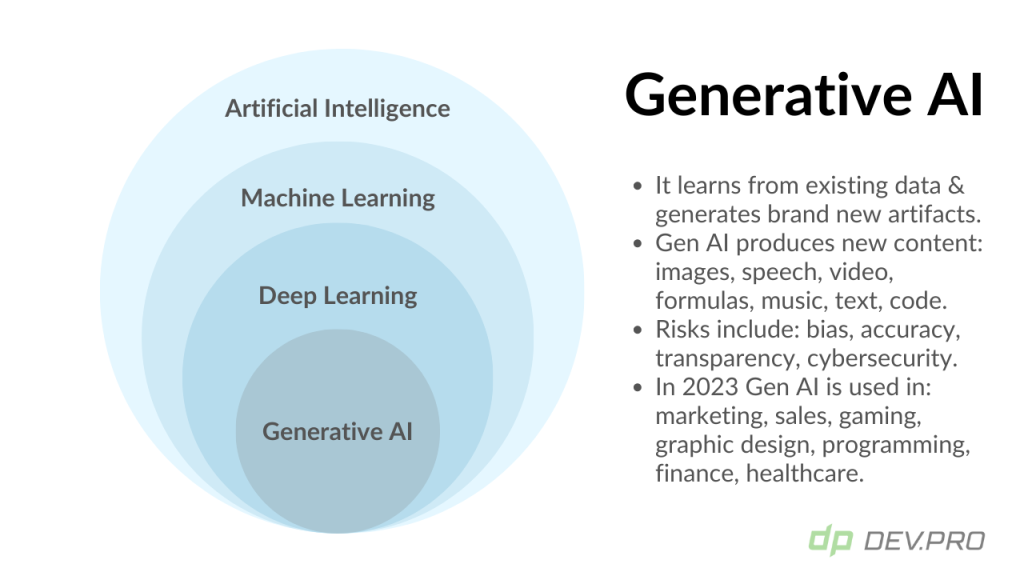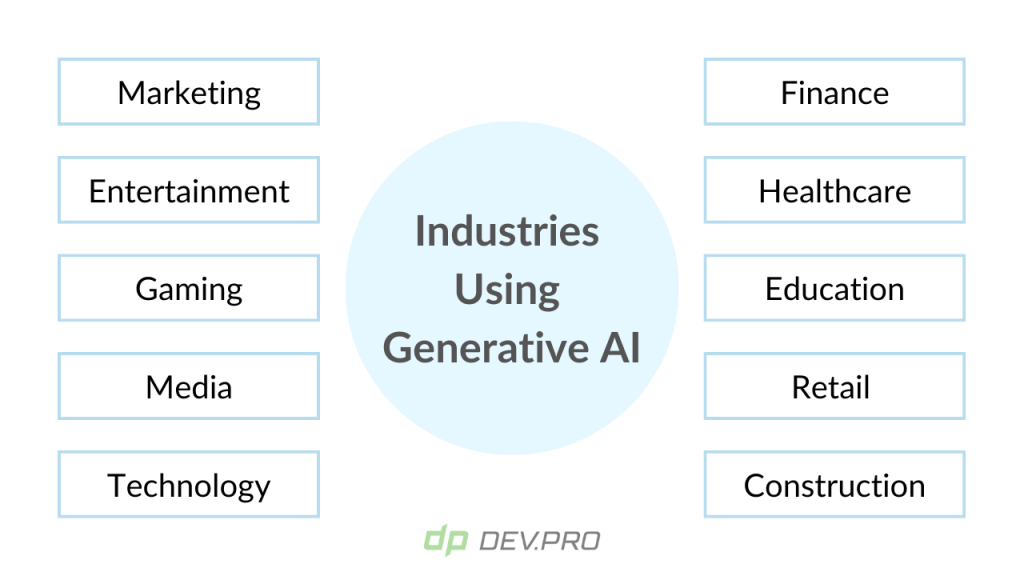Generative AI, just like Artificial Intelligence (AI) in general, is here. And it’s here to stay.
For good or for bad — is up to Human Intelligence.
Concerns about how rapidly AI can outgrow levels of human intelligence, and the consequences, have been raised by the likes of Elon Musk and Yuval Noah Harari. A group of industry leaders from Apple, Stability AI, MILA, Ripple, and academics from top global universities, wrote an open letter suggesting that AI models training beyond GPT-4 be paused for six months to give governments time to create some legal mechanisms.
Future of Life Institute: Open letter on temporarily pausing AI model training
That said, AI uses have been expanding exponentially because AI is capable of learning and perfecting itself based on the data it is given to train on. And the general consensus is that AI will exceed human intelligence sooner rather than later, with sentience also a possibility.
Generative AI tools have gained unprecedented levels of popularity and it’s a race against time now which businesses get to use the technology faster and in more efficient ways.
According to Descript’s survey of 1,004 podcasters, 65% used some Generative AI tool to create content and 78% confirm the likelihood of using it in the future. And where it is used, GitHub Copilot writes 61% of Java code in editors.
In this article, we consider how different industries are applying Generative AI in 2023. As an AI software development company, Dev.Pro is both: thrilled to fully onboard this technology into our ever-evolving tech stack, and responsible to ensure human intelligence makes this endeavour safe and beneficial for all parties: our clients, team and users.
But first some fundamentals.
What is Generative AI?
Generative Artificial Intelligence [generative AI] is a subset of a wider computer science discipline called AI. It’s a software system that uses algorithms to train models on vast amounts of data to generate content following human prompts. Popular generative AI tools include DALL-E, ChatGPT, GitHub Copilot, and Bard. Text, video, audio materials, and code are the prime types of content currently successfully generated by AI.
How do generative AI systems work?
Generative AI systems are a subset of one of the most complex subsets of AI — Deep Learning (DL), which in turn, is a subset of Machine Learning (ML). Check this Venn diagram for a better understanding of the dependencies between these concepts.

In order to train a generative AI tool to produce content of its own, the system is first trained on a vast amount of all types of data, so it can pick up connections and dependencies between different data points.
So, Generative AI can use both of the learning models characteristic to ML:
- supervised learning model, where data are tagged, and
- unsupervised learning model, where the algorithm is left to figure out any dependencies on its own without any hints derived from tags.
On top of the two models used by ML, Generative AI can also use the semi-supervised model learning characteristic of the DL algorithms. The DL functions on the complex multilayered networks of nodes (or neurons). This semi-supervised learning model suggests that a system is given a small amount of tagged data and a large amount of untagged data to build an understanding of how they relate to each other.
Large Language Models, or LLMs, are also a subset of DL and used for GenAI, specifically its generative type. While the discriminative type can be used only for classification and prediction purposes—it’s trained on tagged data—the generative LLMs can actually create data similar to the sets they have been trained on.
Even though many GenAI startups are emerging these days, training models requires lots of time and huge computational capacities. This is why businesses often use AI Google, AWS, IBM, and Microsoft artificial intelligence platforms and solutions. Let’s consider some of the popular Generative AI uses in various industries.
Generative AI applications: Taking Creative Industries By Storm & Far Beyond
Generative Artificial Intelligence is increasingly popular as a robust tool, transforming industries and revealing new horizons in strategizing and content creation. By leveraging DL algorithms, generative AI systems can produce new content, imitate human-like reasoning, and expedite technological transformation. In this piece, we will delve into the evolving applications of generative AI and examine how this technology is revolutionizing economic segments as diverse as design, healthcare, chemistry, gaming, entertainment, marketing, and more.
Entertainment & Media
Text, audio, and video content generation are at the core of major use cases of tools like MidJourney, ChatGPT, Stabe Diffusion, and Pictory. These uses of generative AI will shape the entertainment industry in the next five years:
Content Idea Generation & Improvement
Journalists, social media influencers, YouTube podcasters, and movie script writers are already using generative artificial intelligence systems to create ideas, gather information, and draft their texts.
Netflix, for example, recently made their new AI-powered Magenta Green Screen invention public. This technology creates visual effects in a fraction of the time that traditional green screens used to take.
Personalization & Enhancement of User Experience
With corporations like Apple and Amazon entering the movie-making industry, the streaming and entertainment industry has had an influx of highly technical talent, reshaping the realm in the last few years. It was not a good time for Netflix to relax.
With generative AI capabilities, viewers may expect ultimate personalized experiences sooner rather than later—it’s not too far-fetched to imagine that viewers may soon create their own content in near real time based on verbal prompts to a remote control.
Not only are Netflix recommendations different based on browsing history, but the image covers used on the platform also change for different demographics. The AI algorithm is used to gauge which image is more likely to resonate with a specific audience and trigger higher engagement rates.
Metadata Generation & Enrichment
In order to be searchable on the internet, movies on streaming platforms need to have rich metadata with descriptions, actors, movie genre, and so on. Similarly, creation of keywords for specific images is a perfect task for AI, which can analyze the image and produce just the right keywords so that users and search engines can find these materials.
Finding Ways to Improve Monetization
Churn rate is critical for OTT players, as switching is so easy for users. Gen AI usage in media and entertainment will likely be part of the solution to retaining customers and getting more out of their screen time through personalized, more targeted advertising.
Marketing
Content generation in marketing is getting better, quicker, and more diverse all at the same time. Google text-to-image generation model Imagen can create new images from a limited batch of original training uploads, change image resolution as required, create audience-targeted ad copy for social media, align the copy with the brand voice, and even A/B test the better copy. Need to personalize your messaging and want to speak in the language of your customers? No problem. AI capabilities of Google Workspace allow for that, too.
These marketing segments are most likely to reap the biggest profits and optimization from Gen AI tools by creating emails, social media posts, videos for YouTube, and so on.
- email marketing
- SEO optimization
- social media marketing & podcasting
- affiliate marketing
Top uses of generative artificial intelligence tools for marketing include:
- creation of content for blogs, podcast
- optimization of existing content to drive open rates, CTR
- metadata and keyword creation
- creation of advertising materials—from copy to images and videos
- generation of ideas for content planning
Dev.Pro has helped our restaurant tech client Popmenu create software for social media content generation that allows users to generate social media posts quickly and intuitively. Read more about this project here.
Finance
Financial institutions have undergone a significant shift with digital transformation, as cloud, blockchain, and cashless payment technology changed the way to pay in the last few years. AI is here to build on all the recent innovations and transformations, making them more agile and exponential in nature.
The financial sector uses generative artificial intelligence for these applications:
Fraud Detection, Investigation & Prevention
Fraudsters are usually tech savvy people who know that time is critical. Whenever a fraudulent translation takes place, the money or the agents have to move quickly. GenAi’s computing capacity allows it to process multiple data points against an array of different metrics to predict if a certain translation is likely to be fraudulent and flag it for review.
The systems can be used for multiple activities like fraud identification, investigation, and prevention. Bank of America, PayPal, and Visa all leverage artificial intelligence tools to perform at least one of these activities.
Customer Service Automation
Chatbots and personal assistants are already bringing savings across multiple industries. GenAI’s ability to understand both text and human voice input combined with the ability to comprehend the enquiry and generate answers makes them irreplaceable in customer service departments of financial services providers.
Portfolio Management
Systems can analyze past trends and current conditions to predict future trends. Artificial intelligence systems are widely used to analyze existing investment portfolios against current market conditions and forecasts to improve portfolios.
Credit Scoring
Lending market players have employed smart AI algorithms to estimate clients’ creditworthiness quicker with better accuracy. This allows companies to provide credit in the right conditions to the right clientele—and most importantly, not to lend funds to people with poor credit history.
Healthcare
The healthcare industry has already undergone a robust transformative phase through the application of generative AI. One of the most influential uses of this technology is in medical imaging, and roentgenologists are likely to be using multiple AI tools to arrive at diagnosis in the nearest future. Some of the proven GenAI uses in healthcare include:
Drug Discovery and Design
Drug discovery and development is a complex and lengthy process with potentially life-saving outcomes. Any technology that can precipitate some development phases will see a lot of interest supported by hefty investments from the pharma industry. Generative AI can generate new molecular structures and help predict their properties, accelerating the discovery of new drug formulas.
Patient Screening
Diagnosis and patient screening are the prime use of artificial intelligence for one reason: however talented or experienced, no doctor is capable of analyzing and storing in their memories as many images and their respective diagnosis as artificial intelligence. Systems are being trained and used right now on a vast body of available X-rays, wound images, snapshots, and videos of surgeries to recognize similar diagnoses when presented with data.
Automated Processing of Documentation
One of the most basic and repetitive functions of the healthcare industry is dealing with documents. Automated processing and documentation can simplify processes for strictly regulated industries, easing the workload for hospital personnel.

Conclusion
Generative AI is capable of transforming pretty much every industry, enabling unheard-of levels of acceleration to many facets of businesses.
As this technology continues to enhance itself and the world in ever-expanding momentum or progress, we can expect more groundbreaking applications, further amplifying human artistry, productivity, and problem-solving competencies.

